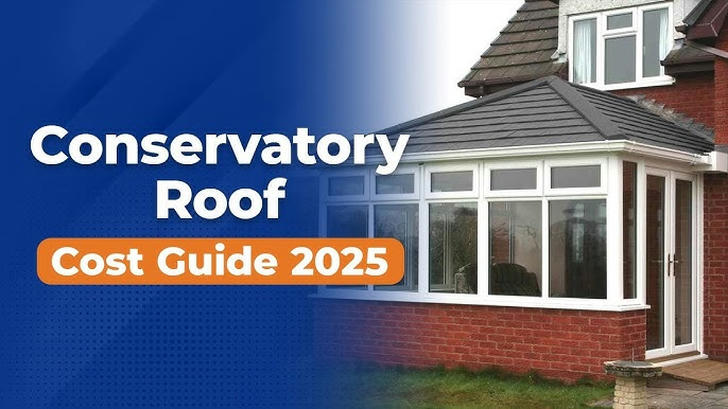How Much Does a Conservatory Roof Cost? | UK Cost Guide 2025
A conservatory roof is not just a functional element—it transforms a space into a year-round haven for relaxation, gardening, or entertaining. However, the cost of a conservatory roof varies widely depending on materials, design complexity, and additional features. This 2025 lastest guide breaks down the factors influencing prices and provides a detailed comparison of popular roof types in the UK market.

1. Material Choices: The Primary Cost Driver
The material you choose for your conservatory roof significantly impacts both aesthetics and budget. Below are the most common options and their 2025 price ranges per square metre:
a. Glass Roofs
🔹Standard Double-Glazed Glass: £200–£400/m²
Ideal for maximising natural light, but requires robust framing to support weight. Thermal efficiency can reduce heating costs over time.
🔹Self-Cleaning or Low-E Glass: £400–£600/m²
Higher upfront costs but lower maintenance, with coatings that repel dirt and improve insulation.
b. Polycarbonate Roofs
🔹Multi-Wall Polycarbonate: £80–£150/m²
A budget-friendly option offering decent insulation and UV protection. However, it may yellow over time and lacks the premium feel of glass.
c. Tiled or Slate Roofs
🔹Lightweight Synthetic Tiles: £150–£250/m²
Mimics traditional materials while reducing structural load. Popular for blending with existing home architecture.
🔹Natural Slate or Clay Tiles: £300–£500/m²
Offers durability and a classic aesthetic but requires reinforced framing and professional installation.
d. Hybrid Roofs
🔹Glass-and-Metal Combinations: £350–£700/m²
Combines modern design with structural strength, often seen in projects like the OUTrial House, where materials like weathering steel integrate functionality and aesthetics.
2. Structural Complexity and Design
The roof’s shape and engineering requirements can escalate costs:
🔸Flat vs. Pitched Roofs: Flat designs are simpler (£1,500–£3,000 for 10m²), while pitched roofs (£3,000–£6,000) enhance drainage and visual appeal but require angled supports.
🔸Custom Features: Skylights, ventilation systems, or integrated solar panels (adding £1,000–£3,000) improve functionality but demand specialised labour.
🔸Historic or Complex Designs: Projects like Maida Vale’s Victorian terrace renovation highlight how restoring period features or integrating bespoke elements (e.g., curved oak staircases) can raise costs by 20–30%.
3. Labour and Installation Costs
Professional installation typically accounts for 50–70% of the total budget:
🔹Basic Installation: £1,200–£2,500 for a 10m² roof.
🔹High-End Projects: Complex installations (e.g., tiled roofs with structural reinforcements) may exceed £5,000.
🔹Regional Variations: London and Southeast England often command higher rates due to labour and material costs.
4. Additional Features and Long-Term Costs
a. Insulation and Energy Efficiency
Investing in thermal breaks, insulated glazing, or roof insulation (e.g., 270mm mineral wool at £8–£12/m²) can improve Energy Performance Certificate (EPC) ratings and reduce heating bills.
b. Maintenance Plans
Regular upkeep, such as moss removal (£599/year for a bronze-tier plan) or gutter cleaning, prolongs roof lifespan and prevents costly repairs.
c. Planning Permissions
While most conservatories fall under permitted development, conservation areas or listed buildings may require approvals—budget £200–£500 for applications.
5. Case Studies: Real-World Cost Breakdowns
a. The OUTrial House
This “outrial” design used a grass-covered roof merged with an internal atrium. While unconventional, its hybrid structure (combining steel and glass) cost approximately £45,000 for 1440m², showcasing high-end material efficiency.
b. DeDraft’s Weathering Steel Extension
A 24m² roof extension in Walthamstow utilised pre-weathered steel (£60,000 total), emphasising durability and contextual integration. The material’s longevity justified the higher initial investment.
c. Yellow Cloud Studio’s Courtyard Renovation
A rear extension with a glass-roofed courtyard (£35,000–£50,000) highlights how strategic design (e.g., 3.7m fixed glazing) balances light, privacy, and budget.
6. Choosing the Right Roof: Key Considerations
🔸Budget vs. Longevity: Polycarbonate suits short-term savings, while glass or slate offers durability.
🔸Climate Adaptability: Pitched roofs excel in rainy regions; UV-resistant coatings are essential for sun-heavy areas.
🔸Aesthetic Cohesion: Match materials to your home’s style—e.g., Victorian terraces pair well with slate.
🔸Compliance: Ensure designs meet Building Regulations for insulation and safety.
Conclusion
A conservatory roof is a long-term investment that enhances both living space and property value. By balancing material quality, design complexity, and regional labour costs, homeowners can find a solution tailored to their needs. For further insights into specific projects or materials, explore the detailed guides on [Victorian Terrace Renovations] or [Sustainable Roofing Solutions].
Explore More:
[The Ultimate Guide to Energy-Efficient Home Upgrades]
[10 Stunning Conservatory Designs for 2025]
[How to Choose the Right Contractor for Your Extension]
